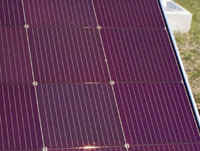
 |
Amorphous Silicon (a-Si) A non-crystalline form of silicon, first used in photovoltaic materials in 1974. In 1996, amorphous silicon constituted more than 15% of the worldwide PV production. Small experimental a-Si modules have exceeded 10% efficiency, with commercial modules in the 5-7%. Used mostly in consumer products, a-Si technology holds great promise in building-integrated systems, replacing tinted glass with semi-transparent modules.

Cadmium Telluride (CdTe)
A thin-film polycrystalline material, deposited by electrodeposition, spraying, and high-rate evaporation, holds the promise of low-cost production. Small laboratory devices approach 16-percent efficiency, with commercial-sized modules (7200-cm2) measured at 8.34% (NREL-measured total-area) efficiency and production modules at approximately 7%.
Copper Indium Diselenide (CuInSe2, or CIS)
A thin-film polycrystalline material, which has reached a research efficiency of 17.7%, in 1996, with a prototype power module reaching 10.2%. The difficulty in taking this technology to a production level lies in the difficulty in avoiding the formation of defects during deposition that prevent the formation of uniform layers. (reference #92)